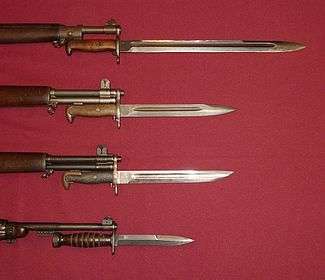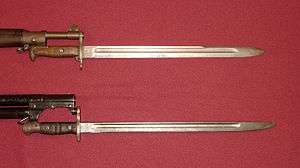M1905 bayonet
| M1905 bayonet | |
|---|---|
 U.S. military bayonets of World War II. Shown are the M1905 bayonet (blued version), M1 bayonet, M1905E1 Bowie point bayonet (cut down version of the M1905) and the M4 bayonet with leather handle for the M1 carbine (bottom) | |
| Type | Bayonet |
| Place of origin | United States |
| Service history | |
| In service | 1905-present (still used on ceremonial rifles) |
| Used by | United States |
| Wars | |
| Production history | |
| Designed | 1905 |
| Manufacturer |
|
| Produced | from 1905 onward |
| Variants |
|
| Specifications | |
| Length |
|
| Blade length |
|
|
| |
| Blade type | Spear point |
| Scabbard/sheath |
|
The Model of 1905 bayonet was made for the U.S. M1903 Springfield rifle.[1] This designation was changed to Model 1905 in 1917, and then to M1905 in 1925, when the army adopted the M designation nomenclature. The M1905 bayonet has a 16-inch (40.6 cm) blade, and a 4-inch (10.1 cm) handle. The bayonet also fits the U.S. M1 Garand rifle. In 1943, a shorter, 10-inch (25.4 cm), bladed version was produced with a black molded plastic handle, and designated the M1 bayonet.
M1942
M1942 is the collector designation for the M1905 bayonet with a black molded plastic handle. It was manufactured in sufficient numbers to keep up with wartime production of M1 Garand rifles. The M1942's blade is also 16 inches long with a 4-inch long handle. The M1905 and M1942 bayonets are interchangeable and can be used on both the M1903 Springfield and M1 Garand rifles. The designation M1942 was never officially adopted by the army; all sixteen-inch blade bayonets were referred to as M1905, regardless of the construction of their grips.
| M1942 production (1942–43) by manufacturer [2] |
Number |
|---|---|
| American Fork and Hoe | 350,000 |
| Oneida, Limited | 235,000 |
| Pal Blade and Tool | 250,000 |
| Utica Cutlery | 225,000 |
| Union Fork and Hoe | 385,000 |
| Wilde Drop Forge and Tool | 60,000 |
M1905E1 and M1 bayonets
In 1943, the U.S. Army decided to shorten the M1905 bayonet's blade to 10 inches (25.4 cm) and as many of the M1905 and M1942 bayonets as possible were recalled, their blades were cut down to size, and were reissued. These shortened M1905 bayonets were re-designated as M1905E1.
The U.S. Army also introduced a new M1 bayonet which was designed to be used with the M1 Garand rifle. The M1 bayonet's blade is 10 inches (25.4 cm) long and the handle is 4 inches (10.1 cm) long.
These shortened bayonets functioned well in the European theater, where in the rare bayonet-actions of the time they were matched up against the 93⁄4-inch long blade of the German S84/98 III bayonet fitted on the Karabiner 98k rifle. However, in the Pacific theater, the Japanese used the much longer, 15.75 inches (25.4 cm), bladed Type 30 sword bayonet on the already very long Arisaka rifle, which caused many American troops to retain the longer, unmodified M1905 bayonet.
Scabbards

The original M1905 scabbard had a wooden body with a rawhide cover and employed a wire belt-hanger which went over and around the supporting belt. The M1910 scabbard was covered in canvas with a leather tip. Wire cartridge-belt hooks replaced the belt-hanger. The M1910 scabbard was the primary scabbard used during the First World War. Earlier M1905 scabbards were modified by replacing the belt-hanger with a belt hook. A green-leather bodied M1917 scabbard (designed for the M1917 bayonet) was approved as a substitute for the M1905 bayonet scabbard.
A new scabbard, the M3, was developed early in the Second World War to replace these earlier scabbards. The M3 scabbard had a fiberglass body, with a metal throat, and was equipped with hooks which fixed to the cartridge-belt.[3]
See also

Notes
- ↑ Note: Variants of the M1903 rifle were produced during World War I and World War II by Springfield Armory, Remington Arms, Rock Island Arsenal, and Smith-Corona Typewriter.
- ↑ USMilitaryKnives.com
- ↑ Canfield, Bruce N.; Bayonet Scabbards for U.S. M1903 Springfields; "American Rifleman;" September 2009; p.48